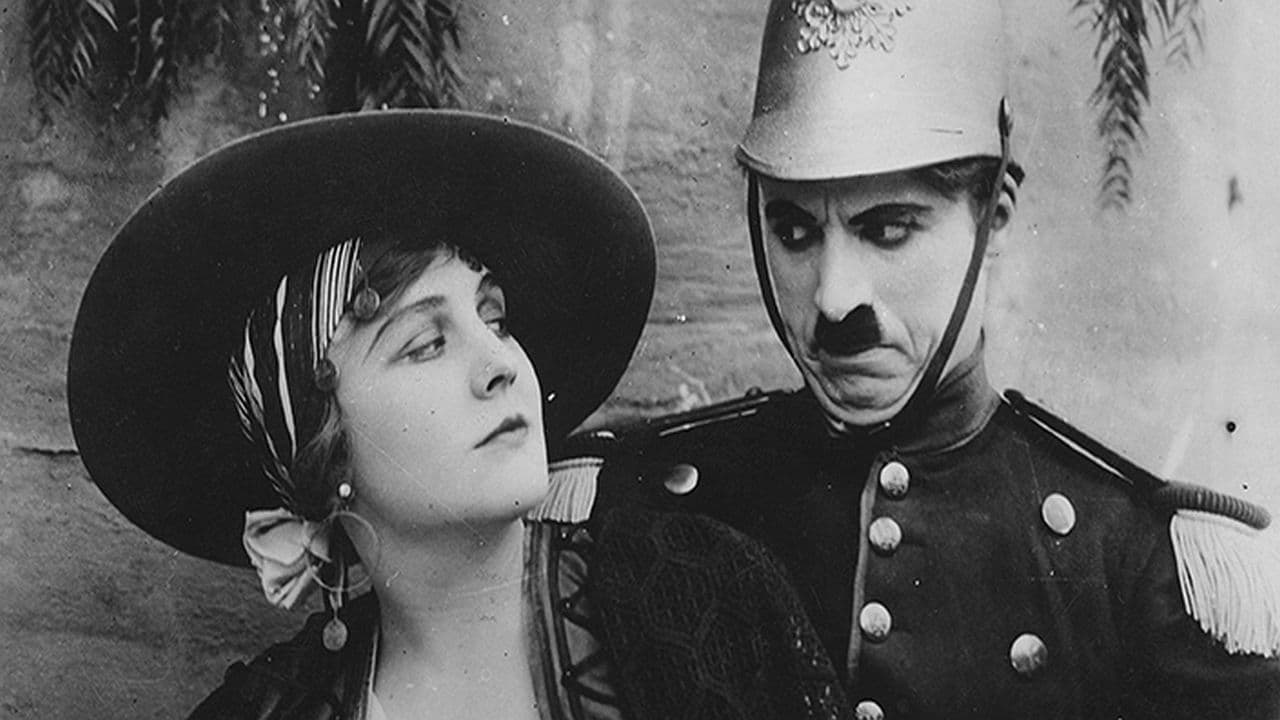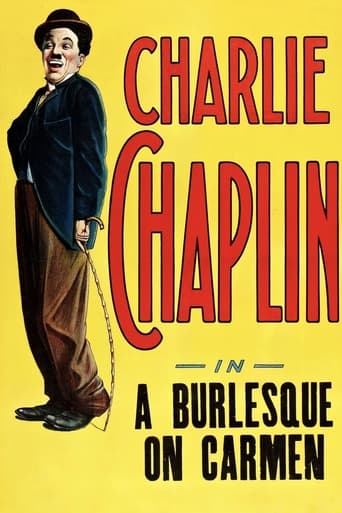Matrixston
Wow! Such a good movie.
Senteur
As somebody who had not heard any of this before, it became a curious phenomenon to sit and watch a film and slowly have the realities begin to click into place.
Loui Blair
It's a feast for the eyes. But what really makes this dramedy work is the acting.
Horst in Translation (filmreviews@web.de)
"A Burlesque on Carmen" is a silent short film from 1915, so this one is of course in black-and-white and it is now already over a century old. The version I watched ran for slightly over half an hour, but I see there's also version out there that run for over 40 minutes. And there is one that features Peter Sellers as narrator, which is a bit strange as this is a silent film like I wrote. is he reading the intertitles? I am not sure, but if you like him , then perhaps that's the version to choose for you. The title already gives away that this is another version of the famous Prosper Mérimée story about Carmen and she is of course played by Chaplin regular Edna Purviance. You will find more than just a few other names in here who were really prolific and successful back in the day, even if their most known works are not necessarily associated with Chaplin, such as Jamison, Turpin or White. From that perspective, it is a bit of an oddity for a Chaplin film, but also from the perspective that literature adaptations are not necessarily anything you'd expect Chaplin to star in, even if he clearly changed the material enough for this to work from a comedic perspective. Overall, I cannot say I enjoyed the watch too much and I give it a thumbs-down, even if it is without a doubt, maybe because of the unusual approach, one of Chaplin's most known short film works. Not recommended.
Tom Gooderson-A'Court
Charlie Chaplin's 13th Essanay film is loosely based on Georges Bizet's famous opera Carmen and stars Chaplin as Darn Hosiery, a Spanish Officer on watch at a popular smuggling point. Local barman Lillas Pastia (Jack Henderson) persuades an attractive gypsy girl, Carmen (Edna Purviance) to distract the guard while they smuggle their goods. Despite having no interest in the man Carmen uses her charms to distract Hosiery who ends up in a love quartet for the gypsy's heart.Burlesque on Carmen is an above average Essanay picture and features some nice subtle comedy as well as the usual trips, kicks and pokes. It also features the first noticeably decent performance from Chaplin regular Edna Purviance.Purviance who appeared in every one of Chaplin's Essanay films and went on to appear in over thirty with the comedian over an eight year period had up to now, in my opinion, merely been a background prop for Chaplin to move about and turn his attention to when necessary. Often, through no fault of her own she would play characters with names such as 'A Woman', 'Girl' or 'Maid' but here as Carmen, with a proper fleshed out character, she shines. She is saucy and flirty yet firm and strong headed and is at the forefront of the story. It's nice to see her finally come into her own.What's also nice is for Chaplin to take the action away from his traditional locations such as a house or park and transplant the plot to Spain. This gives him the excuse to try different sets and costumes, many of which add to the humour. He has great fun with a rather bushy military moustache and finds humour in his Uniform. The imagined heat of the Spanish sun also gives Edna Purviance a chance to show her face (and body), often hidden under bonnets and shawls. This is the first instance where I actually noticed the lightness of her hair as it is so often hidden from view. As I mentioned at the top there is a fair bit of subtle humour here to go along with the more obvious attempts. I loved how Chaplin slyly stole a beer and the looks he gave his fellow officer when trying to get 'time alone' with Purviance were fantastic.For me the biggest laugh came when Chaplin is annoyed at a man blowing a horn. He carefully positions himself behind the man, lifts up the back of his tunic, unsheathes his sword, sharpens it, raises it above his head and then kicks him up the arse before returning the sword to its sheath. I loved the misdirection and patience of the joke. Overall I laughed out loud around five or six times which puts it towards the top of the Essanay films in that respect.The final few minutes are surprisingly dark, even for a comedian famed for his pathos. I was totally shocked by just how grim it was and was glad for the final reveal even if the relationship didn't make much sense.www.attheback.blogspot.com
Michael DeZubiria
One of Chaplin's longest films up to that point, Burlesque on Carmen is a clever and surprisingly complex parody of what was then "Prosper Merimee's" well-known story about "Carmen." I was a little confused about the difference between the IMDb's listing of the 1915 Burlesque on Carmen and the 1916 version. Based on the running time I assume that it was the 1915 version that I saw, since the 1916 one is a good 20 minutes longer, and from what I've read, those are 20 unnecessary and unimpressive minutes. From the very beginning, it's clear that Burlesque on Carmen is one of Chaplin's most complex and ambitious efforts to date, starting off with a long back story, told through inter-titles, about the tragic love story of Carmen. Carmen is sent by a band of gypsies ("A band who put the GYP in gypsy."), to seduce a Spanish officer so they can pull off their smuggling operation. It's a clever, Chaplinesque band of criminals, the leader of whom, Lillas Pastia, has "spent 50 years learning to steal, thinking he might be offered a job in politics." On a side note, I've seen some almost misogynistic messages and jokes in some of Chaplin's earlier work, but probably none quite as overt as in this one. Near the beginning of the movie, as the band of gypsies are traveling, there is a scene where the mules and women are loading, and an inter-title explains that "the mules are the ones with long ears." In case you couldn't tell, I guess. Chaplin plays the part of Don Jose, the hapless officer who is to be seduced by Carmen. He is described as "a brave soldier and lover of women." Not exactly a stretch for Chaplin who removed any doubt about his ability to play a convincing comic soldier a few years later in the brilliant Shoulder Arms. And of course, he didn't have to act about being a lover of women.What is different here, of course, is his polished military uniform and straight-backed disciplinary manner, interspersed, of course, with some of his traditional slap-stick moves. He strikes me as a little guy in a position of authority, struggling to maintain the respect of his subordinates by exerting a gruff, stolid exterior.Soon Carmen enters ("Loved by all men under the age of 96…"), and she immediately begins flirting with Charlie. I should mention that for a good majority of the movie, it is surprisingly faithful to the original story, which was full of jealousy and tragedy. Chaplin is strangely convincing as a jealous lover, able to evoke a jealous passion that I've never seen from him. There's at least one scene where he is genuinely a little scary. Chaplin has some great sight gags in the movie, like a hilarious table dance and some classic sword fighting near the end. And his boyish charm and the role of a soldier is also definitely a winning combination, although there is another peculiar stunt involving a group of men pushing a huge door back and forth that wasn't very effective to begin with but just kept going on and on and on, probably about five times longer than it was worth. Although it was interesting that when it finally fell over it clearly was revealed as a movie prop. I always appreciate such glimpses at the old movie sets.The end of the film is it's strongest part. It bears striking resemblance to Romeo and Juliet, but just when you think that Chaplin is going to conduct a major thematic experiment by diverging distantly from his traditional style, there is a hilarious twist that is as vintage Chaplin as anything I've ever seen. Nice work!
Cineanalyst
Chaplin liked Cecil B. DeMille's "Carmen"; this, I think, was his only effort devoted to parodying a sole film. I disliked DeMille's "Carmen"; neither the direction, nor narrative impressed me, and Geraldine Farrar was annoying. Edna Purviance is much easier to watch. Her caricature of Farrar's obnoxious narcissism was entertaining and rather satisfying--nearly making the experience of watching Farrar's performance worthwhile. And, Chaplin is funnier here than in any film he had done before. This, not "The Champion", "The Tramp", or "Police", is what I consider the jewel of his outturn at Essanay.This short follows the same plot of DeMille's "Carmen", nicely condensed, absent the melodrama. And, I'm discussing the 1915 "Burlesque on Carmen", not the bastardized version Essanay created the following year, after Chaplin had left the studio. That one includes a subplot involving Ben Turpin, which pads on two more reels to the formerly 2-reel short. This, the original, preferred version is a visually coherent, appropriately photographed short (other than some jump cuts). Chaplin took the style, or look--tinting, mise-en-scène, composition and such--right out of DeMille's film. As a result, this is one of Chaplin's better-looking films from his early work. If nothing else, DeMille made some pretty pictures.Chaplin did transform, or mature his comedy while at Essanay; although, of his Essanay films, only a few are very discernible from his Keystone shorts. You may witness a slight maturing in his other Essanay movies, but "Burlesque on Carmen" seems to introduce a radically more mature burlesque for Chaplin. And, I mean "burlesque" in two senses: first, this film is a burlesque in that it parodies another film, and, second, it may be that Chaplin learned to refine the broad, crude and frantic humor of his Keystone upbringing in the process of parodying that film. There's a clear focus here--in parodying DeMille's film, and thus we get a substantial refinement in Chaplin's style.There are some very funny moments here, too. The swordfight, which turns into a wrestling match, is great. Chaplin continually interrupts the photoplay by breaking down the fourth wall, including winking at the camera. Another of my favorite gags is when Chaplin, looking as close to the tramp as in any part of the film, stops at a saloon before continuing with the expected storyline.

